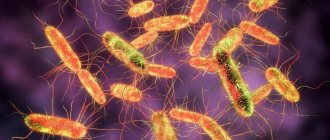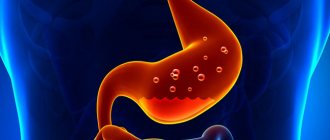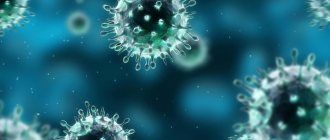Stomach flu
- this is not one, but a whole group of viral diseases, in which symptoms are pronounced, similar to intestinal pathologies, in particular gastroenteritis. The disease received its name due to the similarity of clinical signs with regular flu, namely:
- outbreaks during autumn and winter;
- rapid infection occurs, up to epidemics;
- catarrhal lesions are observed in the oropharynx;
- the disease is transmitted by airborne droplets (one of the methods);
- the disease lasts on average 7 days.
Those at risk are more likely to get sick
The group most susceptible to intestinal flu infection is young children under 3 years of age.
, about 50% of all intestinal problems are associated with this disease. It is worth noting that when breastfeeding, the baby is protected by the mother’s immunity, and the incidence of diseases during this period is extremely low. If the child is weaned, then in such cases infection is registered already from 3 months of age. After an illness, the child gains immune experience and the risk of further infections is reduced.
Older people get sick much less often; on average, this is every 4th case of intestinal infection.
Also included in the risk group is
people with weakened immune systems:
- in the presence of transplanted organs;
- cancer patients;
- for chronic gastrointestinal diseases;
- HIV patients;
- pregnant women.
The danger of intestinal coronavirus
This condition is dangerous not only because an inflammatory reaction develops, but also because during vomiting and diarrhea, the human body loses a large amount of fluid, which can result in dehydration (dehydration). Elderly people with additional chronic diseases are at particular risk. For them, this condition poses a threat not only to health, but also to life.
Diagnostics
By analogy with the respiratory form of coronavirus, diagnosis of the intestinal form of the disease is carried out using a laboratory PCR test. The nature of the patient's complaints is taken into account.
Causes of intestinal flu
As mentioned above, the cause of this disease is viruses that have the ability to carry out their life activities in the epithelial cells of the small intestine.
Adenoviruses
They have increased resistance and survival, as a rule, they affect the upper respiratory tract, are accompanied by conjunctivitis, and the epithelium of the small intestine is also affected. This virus is especially dangerous for children under 2 years of age; adults, as a rule, have acquired immunity. The method of transmission is airborne, fecal, through contact with household items, food, water. Disinfection methods are ineffective; ultraviolet light is used to destroy viruses, or when heated to more than 60 degrees.
Rotaviruses
It selectively affects the upper respiratory tract and epithelial cells of the small intestine; during an exacerbation, it circulates in the blood and affects liver cells. Standard disinfection methods are not effective; the virus is very resistant and only dies when boiled. Remains viable on surfaces (eg fruit, door handles, towels) for up to 14 days.
Noroviruses (Norwalk)
It got its name from the city in the USA Norwalk, where an epidemic of “stomach flu” accompanied by vomiting was recorded. There is very little data about this virus, it is also very stable and has strong survivability, does not respond to standard disinfection methods, and dies at high temperatures. The disease spreads through water, food, contact household items, and seafood.
There are also Toroviruses and Astroviruses, but they are extremely rare.
Rotavirus infection. Symptoms and treatment
Rotavirus infection (rotavirus gastroenteritis or “intestinal flu”) is an acute viral disease that is characterized by symptoms of general intoxication (weakness, lethargy, decreased appetite up to its complete absence, pale skin), damage to the gastrointestinal tract, and dehydration. Rotavirus is the most common causative agent of gastroenteritis in young children, ranking second after acute respiratory infections in all countries of the world.
Children aged 1 to 5 years are most often susceptible to this infection, although the most striking clinical manifestations usually occur in children from 6 months to 2-3 years. However, infants also suffer from rotavirus infection, but they are to some extent “insured” from it, since they have maternal antibodies (so-called passive immunity), which prevent the virus from entering the body. Rotavirus infection has a pronounced seasonality: the incidence increases in the autumn and winter months, remaining at a high level in December-March. Winter seasonality is associated with better survival of rotaviruses in the environment at low temperatures (even repeated freezing does not destroy the virus). However, the virus loses its infectivity when boiled and treated with 95% alcohol. Considering that the virus is widespread, it is, unfortunately, not very difficult to “catch” it. The source of infection is only humans. The pathogen is excreted in feces for up to 3 weeks (usually 7-8 days from the onset of the disease) with maximum excretion in the first 3-6 days. Most often, infection occurs through the fecal-oral route (through household items, cooked food, etc.), that is, we can say that this is a disease of “dirty hands.” Another frequent and most common route of infection is through water (river, well and tap water). From the very beginning of the disease, rotavirus affects the mucous membrane of the stomach and small intestine, which leads to impaired digestion of food, the development of severe diarrhea and dehydration.
HOW DOES ROTAVIRUS INFECTION START AND MANIFEST?
The incubation period of rotavirus infection lasts from 12-15 hours to 5-7 days (usually 1-2 days). The disease begins acutely. A detailed picture of the disease is formed within 12-24 hours from the onset of infection. From the very beginning, the disease can manifest itself as a slight runny nose and sore throat, so rotavirus is often mistaken for a banal acute respiratory infection. However, this is just the beginning. Then the classic triad of symptoms of rotavirus infection appears:
- Fever. The temperature reaction usually does not exceed 38-39°C and lasts for about 2-4 days. It may be accompanied by symptoms of intoxication.
- Vomit. One of the first and often leading signs. It usually precedes or occurs simultaneously with diarrhea. Repeated vomiting is typical, less often - repeated, but it is always short-lived - about 1-2 days.
- Intestinal dysfunction. It is characterized by copious, liquid, mushy, often watery, foamy yellow stools, usually without pathological impurities (blood and mucus). Sometimes there may be a short-term yellow-greenish coloration of feces and an admixture of clear mucus. The frequency of stool is usually determined by the severity of the disease and can range from 2-5 times a day in mild cases and up to 20 or more times in severe cases. The duration of diarrhea usually does not exceed 3-6 days. Intestinal dysfunction is accompanied by abdominal pain, which can be of varying degrees of severity, diffuse or localized in the upper half of the abdomen. Episodes of cramping pain may occur. Many children experience bloating and rumbling in the abdomen.
In the vast majority of cases, the course of rotavirus infection is favorable and recovery occurs on the 5-7th day. Immunity after rotavirus infection is unstable and lasts for a short period of time. This means that once a disease has been contracted, it will not protect your baby from subsequent infections, but with adequate treatment and timely consultation with a doctor, complicated forms of the disease can be avoided.
TREATMENT OF ROTAVIRUS INFECTION
The main goal in the treatment of rotavirus infection is to combat dehydration (that is, restoration of the volume of lost fluid) and intoxication. These two main components of the disease very often lead to dysfunction of vital organs, primarily the kidneys and organs of the cardiovascular system, which can cause serious complications. Oral rehydration (replenishment of lost fluid through the mouth) is currently widely used. In the pharmacy chain you can purchase ready-made dry powders that are easy to use: they should be diluted in the suggested amount of water.
It is difficult to calculate the volume of oral rehydration on your own, so you should not self-medicate! You definitely need to see a doctor!
Enterosorbents, probiotics, prebiotics, enzymes, antidiarrheals and other drugs are also used for treatment. There is currently no specific treatment for rotavirus infection.
Diet for rotavirus infection:
- Feeding the child should begin after 4-6 hours of oral rehydration;
- In no case should you give your baby water-tea breaks or “starvation” diets;
- during the acute period of the disease, milk and dairy products, as well as foods rich in carbohydrates (sweets, etc.) should be excluded from the diet;
- if the child is bottle-fed, he should be offered fermented milk, low- and lactose-free formulas;
- the frequency of meals can be increased, but its volume, on the contrary, needs to be reduced;
- food should be easily digestible, age-appropriate and sufficiently high in calories;
Depending on the age, severity and course of the disease, adequate nutrition is restored by 4-6 days.
PREVENTION OF ROTAVIRUS INFECTION
The main prevention of rotavirus infection is compliance with sanitary and hygienic rules. It is necessary to provide careful care for young children with the treatment of nipples, toys, dishes, linen, hands, to exclude contact with sick people and virus carriers, and to limit the child’s visits to public places with large crowds of people. It is also necessary to carefully observe the sanitary and hygienic regime in the process of preparing food and storing food. The living space should be frequently ventilated and wet cleaning must be carried out. Immune drugs can be used as preventative and therapeutic agents (after consulting with a doctor!).
Dear parents! Timely seeking medical help will help your child avoid complicated course of the disease!
Author: Head of the infectious diseases department of the Slutsk Central District Hospital Lutsevich N.A.
How does stomach flu spread?
The disease spreads through infected people, through airborne droplets, and through feces
.
In other words, the virus spreads through contact objects, poorly processed foods, and neglect of personal hygiene. Intestinal flu spreads especially quickly in kindergartens, shared toys, tables, chairs, door handles, bed linen, pots.
I would especially like to note infection through bottled drinking water. There is evidence of large epidemics of intestinal flu that spread in this way. The fact is that these viruses can remain viable in water for months.
Why does it happen?
Poor nutrition can serve as a breeding ground for infection.
When a weakened body cannot fight against viruses, diseases such as:
- Escherichiosis;
- klebsiellosis;
- dysentery;
- salmonellosis;
- diarrhea;
- staphylococcal infection.
These phenomena are the cause of intestinal infections. The appearance of these diseases is facilitated by a lack of normal nutrition, eating dirty vegetables, and drinking water that contains these bacteria. When they enter the body, they are sent through the stomach to the intestines.
How does intestinal flu develop?
Viruses that cause disease enter the human body through the oral cavity, food, water, saliva, and dirty hands.
. They are not afraid of the acidic environment of the stomach; they easily overcome it and enter the intestines.
The main task of the intestines is to extract nutrients from food by breaking it down into its component parts using enzymes.
The entire surface of the intestinal walls is dotted with special villi, and these, in turn, are covered with epithelial cells - enterocytes. Intestinal influenza viruses, like parasites, penetrate these cells and begin to actively multiply, while the activity of the cell itself stops. Having reached critical filling, the cell literally explodes and mass infection of all surrounding cells occurs, the process repeats. As a result, first of all, the absorption of carbohydrates is disrupted; they begin to accumulate, creating a “plug” in the intestines. The body begins to supply liquid to dilute the resulting congestion, because of this, irritation of the intestinal walls occurs and reflex peristalsis is triggered, in simple words, diarrhea and diarrhea begin.
As a result of the overflow of the duodenum, food from the stomach cannot move normally, contractions of the walls begin and food comes out in the form of vomiting.
The immune system reacts to what is happening with the emergency production of specific antibodies, and the source of infection begins to decrease. Virus particles come out in the stool and begin a new round of infection.
Diagnosis of the disease
At the first appointment, the therapist listens to the patient’s complaints, studies the medical history, conducts a visual examination and palpation of the abdomen, measures body temperature and blood pressure.
To differentiate viral gastroenteritis from bacterial and determine the severity of the condition, laboratory diagnostics are performed, which may include:
- general and biochemical blood test;
- general urine analysis;
- examination of stool and vomit.
If necessary, the therapist refers the patient for consultation with a gastroenterologist or infectious disease specialist.
How does intestinal flu proceed, symptoms, signs
As has already become clear, this is essentially a group of diseases caused by various viruses, and the symptoms, as well as the course, are slightly different. On average, 7-10 days pass from the time of infection to the first manifestations. However, an infected person begins to infect others even before the first signs and symptoms of intestinal flu begin; this occurs towards the end of the incubation period.
As a rule, the onset of the disease is marked by a sharp rise in temperature of 38-40 degrees, diarrhea and vomiting. Less often, the patient begins to feel a loss of strength, a reluctance to eat, a headache, and may have a slight fever, but the next day, diarrhea and vomiting will definitely occur.
As a result of loose stools, the body rapidly loses fluid, dehydration occurs, this is very dangerous, especially for small children.
The gag reflex, as a companion to the disease, is also very dangerous, because it causes vomiting from everything, even from water. In such cases, hospitalization is necessary.
There may be nasal congestion and sore throat, especially when swallowing.
Temperature and fever last for 2 to 4 days; if this period increases, then most likely there is additional bacterial damage to the microflora.
Symptoms of rotavirus
The disease manifests itself 2–3 days after infection. Typical symptoms include:
- Pain in the stomach and intestines, rumbling in the abdomen
- Nausea and vomiting (especially common on the first day of illness and in severe cases of the disease)
- Diarrhea (it can last 3–5 days, and repeat every hour or a little less often up to 15 times a day)
- Constant urge to defecate
- Heaviness in the stomach and loss of appetite
- General weakness
- White coating on the tongue and swelling of the larynx
- Increase in temperature to 37–37.5 * C (appear more often with severe manifestations of the disease)
- The infection may be accompanied by damage to the upper respiratory tract - rhinitis, inflammation of the nasopharynx and tonsils.
Symptoms in adults?
The first symptoms of infection may not be noticeable.
A stomach infection, the symptoms of which every doctor recognizes, can masquerade as other diseases. Very often, the development of the disease occurs without symptoms, which does not allow it to be detected immediately. The most well-known symptoms of the development of intestinal diseases are:
- Constant aching pain in the abdominal area. It appears due to the presence of bacteria. Usually the pain is not prolonged, but comes in spasms that do not last long (3–4 minutes).
- Diarrhea, as pathogenic microorganisms are present in the body. In such a situation, you should pay attention to the fact that dehydration may occur (this will worsen the situation).
- Reluctance to eat.
- Difficulty with bowel movements.
- Irritable bowel syndrome.
- Insomnia. The question may arise - how is this related to gastrointestinal diseases? In such a situation, the infection causes irritation in the person, which impairs the quality of sleep. During sleep, the body uses the liver to remove toxic substances, but this is not always possible.
- Weak immunity. Bacteria begin to absorb nutrients, weakening the body. This can lead to the development of anemia.
- Grinding of teeth during sleep.
- Depressed state, headaches - this indicates that there is a yeast infection in the body. If you have headaches, you should go to the hospital immediately.
- Rash, itching, and burning.
- Nausea and vomiting. Nausea with varying degrees of intensity.
Prevention rules
The best prevention is to follow the rules of hygiene.
Prevention of various intestinal infections involves procedures that are aimed at preventing the development of this disease in humans.
In order not to suffer from such a disease, you must follow certain rules, including:
- After going outside, before eating, be sure to wash your hands;
- Eliminate sweet foods from your diet when the temperature outside is high;
- Products must be stored in the refrigerator;
- Before eating, rinse vegetables or fruits well;
- Use only fresh products for food;
- Do not drink tap water.
An intestinal infection implies a serious pathological process that can harm a person at any age. In order not to get sick, you must follow the rules listed above, and if you do get sick, contact a specialist.
Quality treatment
Attapulgite - used in cases of diarrhea.
Treatment of this disease should include many measures. Before removing harmful bacteria, it is necessary to eliminate toxins from the body, and then normalize the water balance in the body.
With the help of vomiting and diarrhea, toxins begin to leave the body, and therefore these symptoms can be called to some extent positive.
To remove intestinal disease, it is necessary to rinse the stomach. This can be done using a regular enema. In addition, the disease can be cured using sorbents that can remove toxins from the body. These include:
- Smecta;
- Polyphepan;
- Attapulgite.
When a patient develops intestinal disease, a fasting diet must be followed. This is necessary because food causes an increase in bacteria. You can eat viscous porridges, such as oatmeal, but without salt. It will calm the intestines. It is possible to cure this disease using a solution of rehydron or behydron.
Diet
A child's nutrition should be healthy.
When the disease passes in a simple form, then in order to be cured, you need to take less food, that is, follow a diet.
When the disease is at more serious stages of development, it is necessary to eat 30–50% less than usual, but at the same time you need to eat more often - up to 8 times a day.
If the child is not yet 4 months old, then formula milk must be excluded. In such a situation, a small child must be given mixtures that contain bifidobacteria, lactobacilli, and dietary supplements. If we talk about adults, then if there are intestinal dysfunctions, you should not eat:
- fresh milk;
- black bread;
- various yoghurts;
- fermented baked milk;
- cream;
- boiled beets;
- legumes;
- citrus fruit;
- meat and fish broths.
When a small child has a lack of protein during the course of this disease, it is necessary to add mixtures with it to the diet, starting from the 3rd day of the disease. If the pancreas does not work properly, and malabsorption syndrome has developed, it is necessary to take various medicinal mixtures in food.









